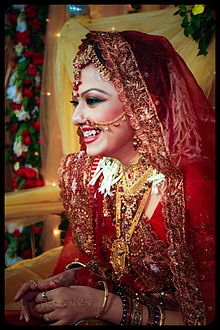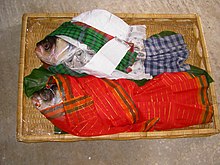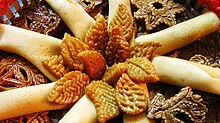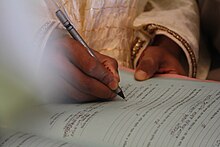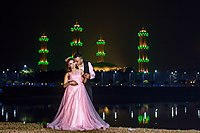
A wedding is a ceremony where two people are united in marriage. Wedding traditions and customs vary greatly between cultures, ethnic groups, races, religions, denominations, countries, social classes, and sexual orientations. Most wedding ceremonies involve an exchange of marriage vows by a couple, presentation of a gift, and a public proclamation of marriage by an authority figure or celebrant. Special wedding garments are often worn, and the ceremony is sometimes followed by a wedding reception. Music, poetry, prayers, or readings from religious texts or literature are also commonly incorporated into the ceremony, as well as superstitious customs.

Baraat or Varayatra is a groom's wedding procession in Indian subcontinent. In Indian subcontinent, it is customary for the bridegroom to travel to the wedding venue on a mare, accompanied by his family members.

The culture of Bangladesh is intertwined with the culture of the Bengal region of the Indian subcontinent. It has evolved over the centuries and encompasses the cultural diversity of several social groups of Bangladesh. The Bengal Renaissance of the 18th early 19th centuries, noted Bengali writers, saints, authors, scientists, researchers, thinkers, music composers, painters, film-makers have played a significant role in the development of Bengali culture. The culture of Bangladesh is deeply intertwined with the culture of the Bengal region. Basically Bengali culture refers to the culture of Bangladesh. The Bengal Renaissance contained the seeds of a nascent political Indian nationalism which was the precursor in many ways to modern Indian artistic cultural expression.
A Hindu wedding, also known as Vivaha, Marathi: Lagna (लग्न), Bengali: Bibaho (বিবাহ), Kalyanam, Kannada script: ಮದುವೆ (Maduve), Tamil: திருமணம் (Tirumanam), or Pelli, is the traditional wedding ceremony for Hindus. The wedding ceremonies are very colourful, and celebrations may extend for several days and usually a large number of people attend the wedding functions. The bride's and groom's home—entrance, doors, wall, floor, roof—are sometimes decorated with colors, flowers, and other decorations.

Gaye holud or Gatro Horidra (গাত্র-হরিদ্রা) is a ceremony observed by Bengalis of Bangladesh and in the Indian states of West Bengal, Tripura and Assam regardless of their religion.
Nador (ನಾಡೋರ) or Nadavaru or Nadavar (ನಾಡವರ) is the name of a caste from Karnataka, India. Members of the castle are found primarily in the coastal areas of Uttara Kannada district, formerly known as North Canara, with many members also spread throughout the world. Caste members traditionally speak the Nadavar dialect of Kannada called Nadavar Kannada. They are a prominent agriculture community of the Uttara Kannada district of Karnataka, India.

Weddings in India vary according to the region, the religion, the community and the personal preferences of the bride and groom. They are festive occasions in India, and in most cases celebrated with extensive decorations, colour, music, dance, outfits and rituals that depend on the community, region and religion of the bride and the groom, as well as their preferences. India celebrates about 10 million weddings per year, of which about 80% are Hindu weddings.
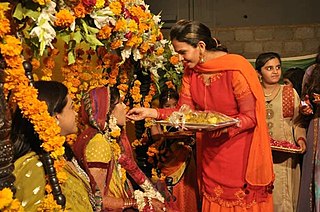
Marriage in Pakistan pertains to wedding traditions established and adhered by Pakistani men and women. Despite their local and regional variations, marriages in Pakistan generally follow Islamic marital jurisprudence. Marriages are not only seen as a union between a husband and a wife, but also an alliance between their respective families. These traditions extend to other countries around in the world where Overseas Pakistani communities exist.

Punjabi wedding traditions are a strong reflection of Punjabi culture with ritual, song, dance, food, and dress that have evolved over centuries.
Arabic weddings are ceremonies of matrimony that contain Arab influences or Arabic culture.
Bengali Hindu wedding refers to the traditional Bengali cultural wedding, usually with Hindu rites and rituals native to the Bengal region of Indian subcontinent which has been practiced through centuries. It has almost uncountable rituals that connect culture, mind and families.
In the United States and Canada, weddings follow traditions often based on religion, culture, and social norms. Most wedding traditions in the United States and Canada were assimilated from other, generally European, countries. Marriages in the U.S. and Canada are typically arranged by the participants and ceremonies may either be religious or civil. There is a tradition that the prospective bridegroom ask his future father-in-law for his blessing.

Traditional marriage customs in the Philippines and Filipino wedding practices pertain to the characteristics of marriage and wedding traditions established and adhered by them Filipino men and women in the Philippines after a period of adoption courtship and engagement. These traditions extend to other countries around the world where Filipino communities exist. Kasalan is the Filipino word for "wedding", while its root word – kasal – means "marriage". The present-day character of marriages and weddings in the Philippines were primarily influenced by the permutation of Christian, both Catholic and Protestant, Hindu, Islam, Chinese, Spanish, and American models.

Muslim marriage and Islamic wedding customs are traditions and practices that relate to wedding ceremonies and marriage rituals prevailing within the Muslim world. Although Islamic marriage customs and relations vary depending on country of origin and government regulations, both Muslim men and women from around the world are guided by Islamic laws and practices specified in the Quran. Islamic marital jurisprudence allows Muslim men to be married to multiple women.
The Telugu Hindu wedding ceremony is the traditional wedding ceremony of the Telugu people in India. In the 19th century, the ceremony could last up to sixteen days. In modern times, it can last two or more days, depending on the family's financial and social status. The pelli or wedding is considered the strongest of social bonds, and is said to spiritually merge two souls opening the doors to gruhastaashramam. There is a Telugu saying that "Marriage is supposed to be a family union and not an individual formality." However, with changing mindset of the younger generation and due to globalization, marriage these days is being mainly focused solely on the union of the young couple only.
Bahaghara is a wedding ceremony performed by Odia Hindu people in the Indian state of Odisha. There are subtle differences in the rites observed by different castes. In Odia marriage rituals, the mother of the bridegroom does not take part in the ceremony. The Utkala Brahmins have their weddings only in the daytime, preferably at midday or in the morning, while the other caste weddings are done during the evening or night. There is the custom of sending betel nuts to family friends for inviting them to the marriage. The first invitation is sent to the family deity as a respect to the lord. Marriages in Odisha are mostly fixed and arranged by the parents. Marriages for serving or capturing is not common.

A Bou bhat is a post-wedding ritual held usually one or two days after a Bengali wedding. In this ceremony a party is hosted by the groom's father or family, where both the bride's and groom's family members and friends are invited. A grand banquet is held at the end of the party which is called Preetibhoj or Preetibhoja and is similar to a gala dinner. In Bengali Muslim wedding after the bou bhat party, the bride and groom go to the bride's family's house for two nights. On the second day, the groom's family is invited to the bride's house for a meal, and they leave with the bride and groom. This meal is called firani or araiya. Shopping is done by the groom for this meal. Similar tradition can be found in other cultures in the Muslim world such as the Walima ceremony.

Bride price, bride-dowry, bride-wealth, bride service or bride token, is money, property, or other form of wealth paid by a groom or his family to the woman or the family of the woman he will be married to or is just about to marry. Bride dowry is equivalent to dowry paid to the groom in some cultures, or used by the bride to help establish the new household, and dower, which is property settled on the bride herself by the groom at the time of marriage. Some cultures may practice both simultaneously. Many cultures practiced bride dowry prior to existing records.
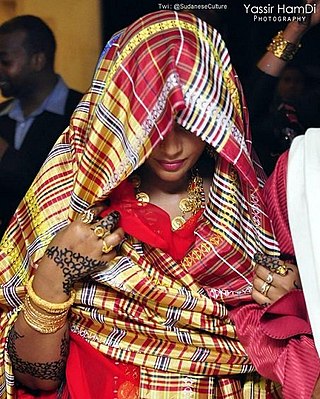
Marriage in Sudan is a fundamental social institution governed by Islamic law and Sudanese culture. Three types of marriages are recognized: traditional, civil, and religious. Arranged marriages are common, with parents typically arranging unions. Child marriage is an issue, with some exceptions to the legal age.

